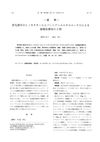Hinokitiol
Research
20 / 37 resultsresearch Hinokitiol, a Natural Tropolone Derivative, Inhibits TNF-Alpha Production in LPS-Activated Macrophages via Suppression of NF-Kappa B
Hinokitiol may help treat hair loss by reducing inflammation and promoting hair growth.

research In Vivo Hair Growth Promotion Effects of Cosmetic Preparations Containing Hinokitiol-Loaded Poly(ε-Caprolactone) Nanocapsules
Cosmetics with hinokitiol-loaded nanocapsules were found to effectively promote hair growth.

research In Vitro Skin Permeation of Hinokitiol Loaded in Vesicles Composed of Behenyltrimethylammonium Chloride and Stearic Acid
Vesicles made of behenyltrimethylammonium chloride and stearic acid can triple the skin absorption of hinokitiol, which may help with hair growth.

research After-Rinsing Hair Growth Promotion of Hinokitiol-Containing Vesicles and Emulsions
Hinokitiol in cationic vesicles promotes hair growth better due to higher skin retention.

research Two Cases of Allergic Contact Dermatitis to Hinokitiol and Pantothenylethylether in Hair Growth Promoter
Hinokitiol and pantothenylethylether in hair products can cause strong allergic reactions.

research Micronization Process of Hinokitiol Using Supercritical Carbon Dioxide
Using supercritical carbon dioxide can change the size of Hinokitiol particles.

research Arachidonate 12-Lipoxygenase Inhibitors Promote S100A3 Citrullination in Cultured SW480 Cells and Isolated Hair Follicles
Inhibiting ALOX12 can help hair cuticle maturation by increasing S100A3 citrullination.
research Application of PLGA Nanostructures to Cosmetics
PLGA nanospheres in cosmetics improve skin and hair treatment effectiveness.

research Polymeric Nanoparticles-Based Topical Delivery Systems for the Treatment of Dermatological Diseases
Polymeric nanoparticles show promise for treating skin diseases.

research Nanotechnology in Dermatology
Nanotechnology in dermatology shows promise for better drug delivery and treatment effectiveness but requires more safety research.

research Preparation and Characterization of Dutasteride-Loaded Nanostructured Lipid Carriers Coated with Stearic Acid-Chitosan Oligomer for Topical Delivery
The new dutasteride formula can be applied to the skin, may promote hair growth, and has fewer side effects.

research Mechanism of Action of Herbs and Their Active Constituents Used in Hair Loss Treatment
Some herbs and their components might help treat hair loss by affecting various biological pathways, but more research and regulation are needed.

research Polymeric Nanoparticles-Embedded Organogel for Roxithromycin Delivery to Hair Follicles
Scientists created a gel with nanoparticles to deliver medicine to hair follicles effectively.

research Nanotechnology-Based Cosmetics for Hair Care
Nanotechnology improves hair care products by enhancing ingredient stability, targeting treatment, and reducing side effects, but more research on its toxicity is needed.

research Hair Growth: Focus on Herbal Therapeutic Agents
Some plants may help with hair growth and have fewer side effects than synthetic drugs, but more research is needed to confirm their effectiveness.

research Hair Growth Promoting Activity of Cedrol Isolated from the Leaves of Platycladus Orientalis
Cedrol from Platycladus orientalis leaves may promote hair growth effectively, especially in female mice.

research Guidelines for the Diagnosis and Treatment of Male-Pattern and Female-Pattern Hair Loss, 2017 Version
Use finasteride, dutasteride, and minoxidil for hair loss treatment.

research Topically Used Herbal Products for the Treatment of Hair Loss: Preclinical and Clinical Studies
Herbal products might promote hair growth with fewer side effects, but more research is needed to confirm their safety and effectiveness.

research Epigallocatechin-3-Gallate Promotes the Growth of Mink Hair Follicles Through Sonic Hedgehog and Protein Kinase B Signaling Pathways
Green tea compound EGCG helps mink hair follicles grow by affecting certain cell growth pathways.

research Hair Growth Promoting Activity of Cedrol Nanoemulsion in C57BL/6 Mice and Its Bioavailability
Cedrol Nanoemulsion was found to be more effective at promoting hair growth than traditional treatments and had better bioavailability.